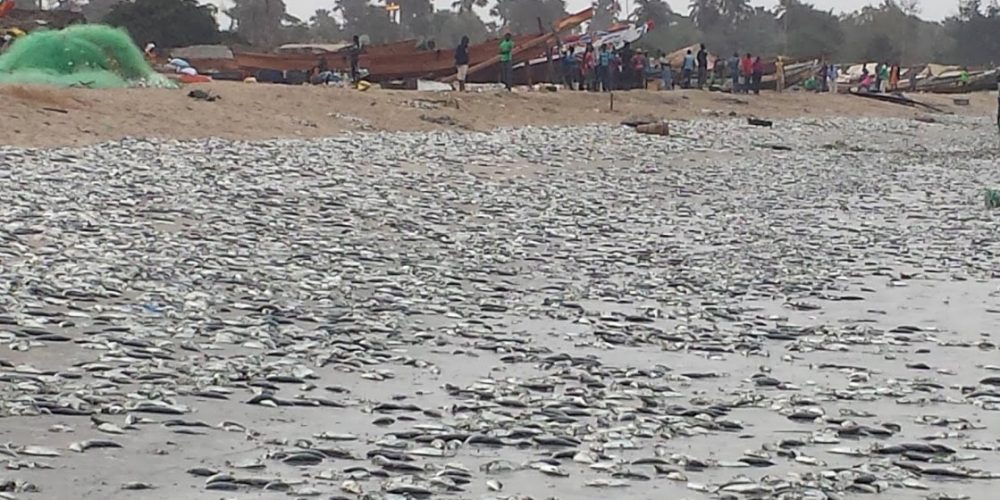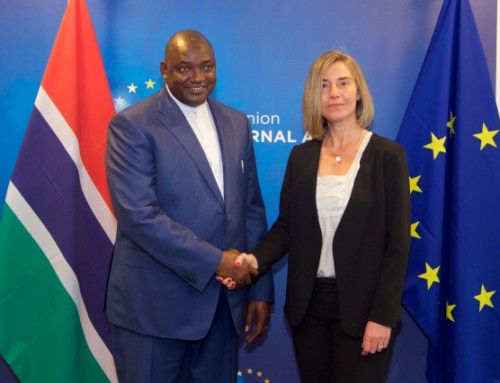By Mathew K Jallow
It was a bit of a mystery that rattled residents of this quiet coastal community. The once idyllic lagoon, Bolong Fengyo, on the outskirt of Gunjur, 35 miles south of the capital city, Banjul, had turned into a river of blood. And on its banks, plant and wildlife; birds, fish, crabs, mangroves, shrimps and other exotic marine life lay dead in large numbers. The mystery soon unraveled, and the community was left with a binary choice; the environmental health of their community or the Fishmeal factory on the outskirts of their village. Thus, began a year pursuing justice, a year that crystalized the dichotomy between Gunjur youth seeking to end the abuse and devastation of their environment, and government’s deliberate stonewalling, which effectively empowered the Fishmeal factory to continue dumping toxic sludge in both the lagoon and coastal fishing grounds. The environmental degradation that Fishmeal factory is causing, at its very root, is underwritten by characteristic state patronage reminisce of Yahya Jammeh’s lax environmental laws, nepotism, ethical indiscipline and corruption. But, the community of Gunjur, led by vibrant youthful consciousness of the pernicious ramifications of the festering environmental crisis, and motivated by primordial instincts, mobilized effective challenge to the state’s patronizing influence over the carnivorous mutilation of an environment critical to the quality of life of Gunjur villagers. The tragedy unfolding in Gunjur, it turns out, is only a snapshot of a much broader scourging of Gambia’s once pristine Atlantic coastline; from Kartong to Bakau, the epicenter of Gambia’s booming tourism industry. The realization that coastal environmental degradation in one community can’t be localized exclusively to that community, awakened consciousness to the gravity of the Gunjur crisis; an epiphany, if you will, which drilled a significant level of environmental awareness in the minds of many Gambians, prompting worldwide interactive engagement around the ongoing Gunjur and coastal communities saga; from Kartong to Bakau, and more broadly; the Gambia.
The breadth of the recklessness of the coastal environmental crisis, and the tunnel vision of officials that borders on pure ignorance, which the government is showcasing, was the tipping point that incentivized Gambians, at home and abroad, to coalesce around the efforts to incite government to void Fishmeal’s fishing license, and demolish their death trap; the factory with toxic chemicals. The insufferable greed, environmental cannibalism and the imperceptible ecological carnage, which Fishmeal factory has precipitated, unduly impacts the lives of communities along the entirety of the Atlantic coast, making the struggle against the malignant presence of Chinese leeches, and their poisonous Fishmeal factory, a chilling recognition of Gunjur’s slow slide into ecological tragedy of apocalyptic proportion. The challenge that confronts Gunjur and the Atlantic coastal communities is underpinned by the ignorant mystification of foreign investment, a Trumpian lack of depth in grasping the consequences of the irreversible environmental damage, and the impact on the cottage fishing industry, the economy, tourism, and the culinary culture of St Mary’s Island, the Kombos. Like most African countries, Gambia is a terrible steward of its resources, and the ocean fish stock, at the undeniable mercy of unlicensed broad day-light Asian fishing pirates, will be depleted before Gambia can benefit from its coastal resources. The land and ocean pollution aside, one of the most pressing needs now is to halt the deliberate and indiscriminate death of millions of young fish using a fishing method banned under Sir Dawda’s government, but which is resurrected and accelerated by the Chinese fishermen along the Gunjur beach. This has the effect of depleting the fish stock, creating a lifestyle and culture altering fish scarcity of Gambia’s stable food, and, hitherto, most reliable source of protein. The urgency of halting this unregulated industrial fishing in Gambian waters cannot be overstated, given the scale of the destruction Chinese industrial fishing has caused in the years since the Fishmeal factory began its operations in the Gambia. But, there is another significant dimension to the Gunjur environmental ordeal relating to a sector of the economy so imperative to Gambia’s economic development now and in the foreseeable future.
Apart from the health consequences of sludge drainage into the open ocean and the effects the dumping of toxic waste has on Gunjur residents and other consumers of contaminated fish, in the Kombos and St Mary’s Island, there is no guarantee that the environmentally conscious tourist arrivals from across Europe will continue to visit when one of the main the attractions, the pristine beaches, are transformed into some hurricane swept Martian landscape. The destruction of an environment is one of the major factors promoting humankind’s movement from place to place, for millions of years. This isn’t an opinion; it’s the fact back by empirical evidence, which technically makes Gunjur a candidate for future exodus of its citizens. The rape of Gunjur’s land and environment prefaces an unpleasant chapter of the future of this quiet community life. Implicit in the life and death saga between the Gunjur community and the well-connected cabal in and out of the government, who, motivated by greed, have forsworn their civic compacts with the citizens, to allow the Chinese companies to splurge in their pursuit of wanton destruction of Africa’s pristine environment. With infinite resources to hypnotize Gunjur elders into a state of selective amnesia, in cohort with corrupt state actors, the Chinese Fishmeal factory is, due to government detachment, granted broad discretion to circumvent Gunjur’s local authority in their quest to expand their cataclysmic ecological destruction of the Gambia’s environment, as they have so tragically done elsewhere all across Africa. The ongoing saga between the community of Gunjur and government, ostentatiously displays the state’s banal overreach, and sneering manifestations of debauchery characteristic of African governments. Gunjur’s plight also reveals a fundamental weakness of the Gambia’s institutions, since the agency responsibility for overseeing the Gambia’s environmental health, the National Environmental Agency (NEA) is so powerless that a single government official, Economic Planning’s Isatou Touray, can casually and unilaterally override the agency’s professional decisions. The display of arrogance by state officials is underpinned by unjustified assumptions of authority, disregard for Gunjur’s community welfare, and a touch of madness that puts material interest over the obligation to protect the national resources. For, even after one year, there is still no end to this sad and ugly tragedy that has befallen one of Gambia’s most dynamic communities; Gunjur.
Source: http://www.wisafricana.com/the-toxic-chinese-fishmeal-factory-and-gunjurs-environmental-catastrophe/





